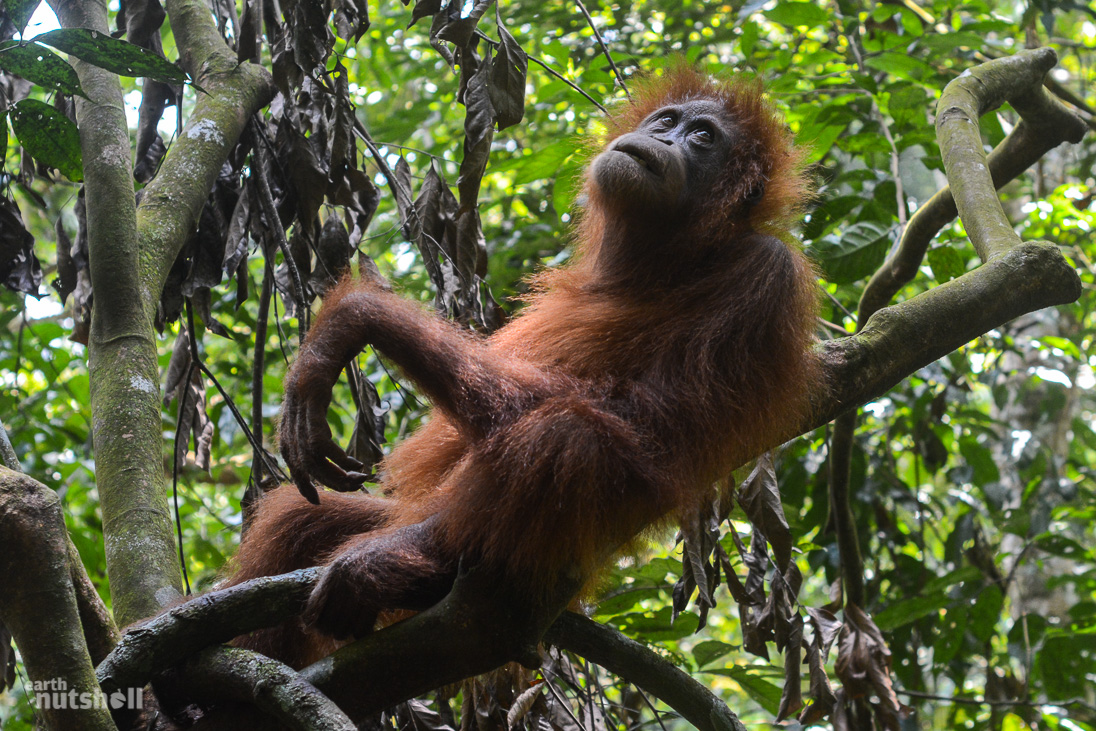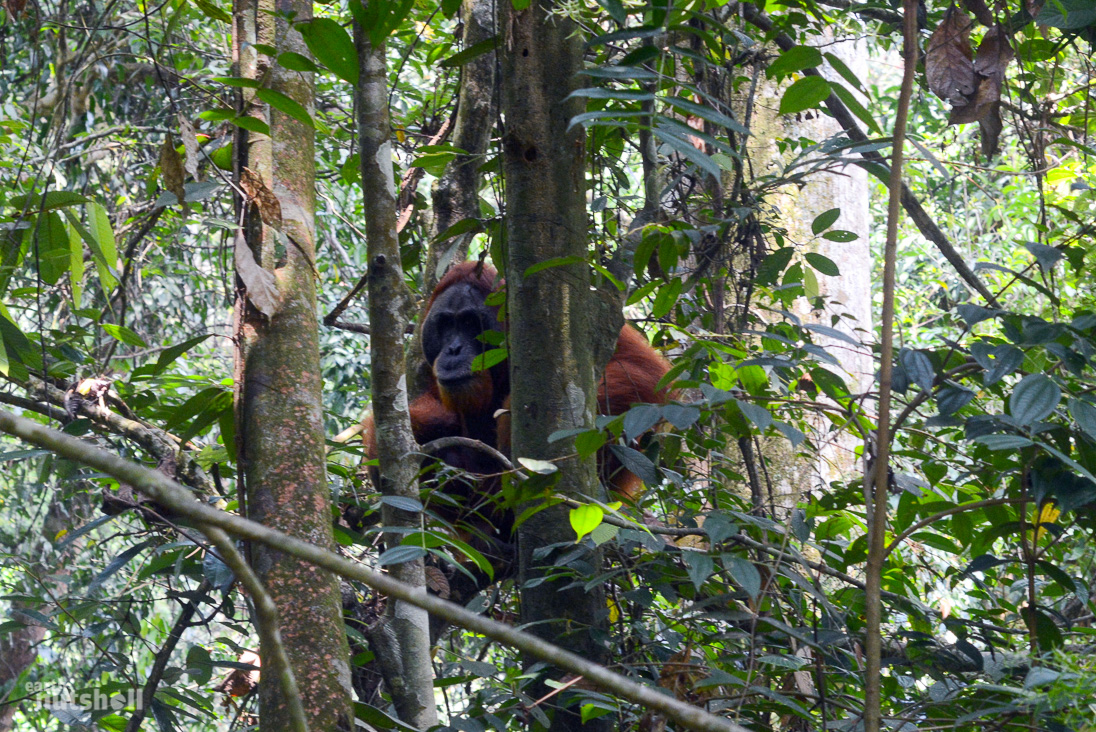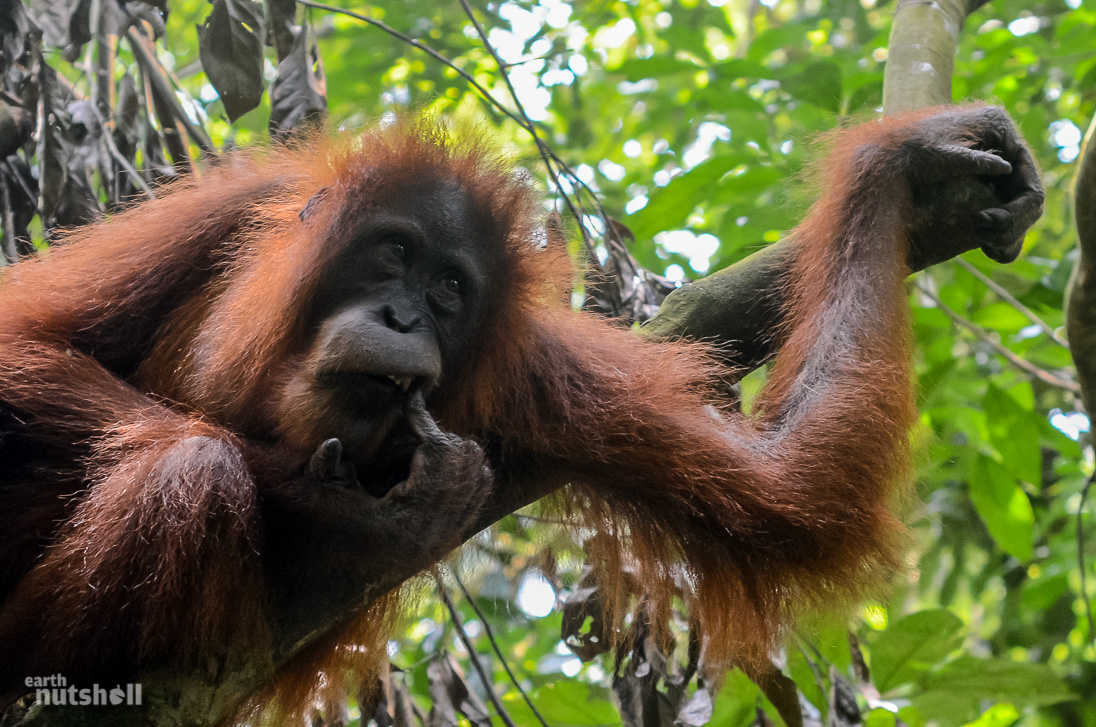In a Nutshell: Orangutan are native only to the islands of Sumatra and Borneo. The village of Bukit Lawang, North Sumatra, Indonesia provides a comfortable, year-round accessible gateway to visit wild Orangutan in Gunung Leuser National Park. Here is the ‘how’, ‘what’ and ‘why’ in making a visit to these Great Apes!
Lets face it, Orangutans are incredible. They are one of four species of Great Apes and share a mindblowing 97% of our own human genetic code. Consider that! To see these intelligent beings gracefully carve through the heights of the rainforest is not something you’ll forget. Although a tempting alternative, a visit in captivity just doesn’t do this majestic animal justice – not when they yearn for jungle freedom.
But at first glance, seeing Orangutans in the wild isn’t exactly easy.
These stunning creatures only live natively in Indonesia and Malaysia, selfishly amidst the rainforest jungles of the islands of Borneo and Sumatra – making it reasonably inaccessible to the average tourist. Both locations closely verge upon being adventure tourism.
But luckily, there is a saviour – one hidden gem not yet overun by tourists, where its cultural integrity remains and the rainforest jungle village lifestyle has prevailed through eco-tourism and a fundamental mutual respect between man and great ape, benefiting both.
The village is Bukit Lawang in North Sumatra, Indonesia and is your most feasible opportunity to see Orangutans in their natural habitat.
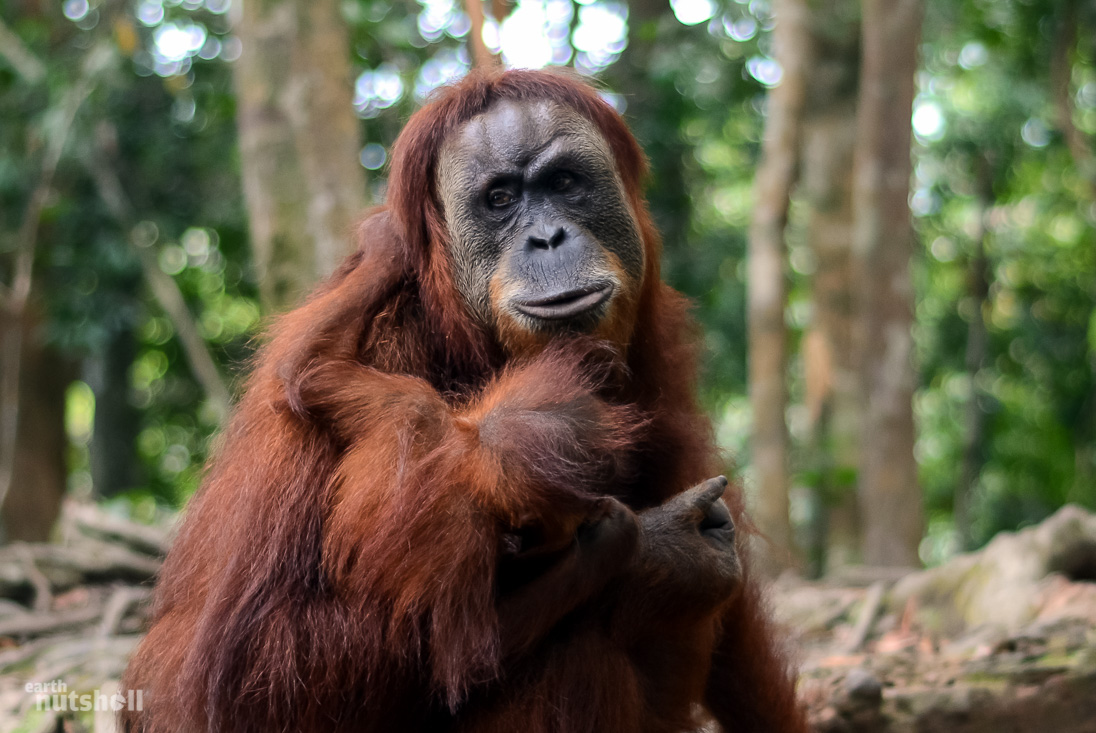
Why Bukit Lawang?
Bukit Lawang is the perfect platform. It provides a comfortable gateway to the jungle at Gunung Leuser National Park – the locals are fantastic, they live and breathe Orangutan and their expertise is invaluable to sightings, with a focus on their survival. Nobody wants to leave disappointed, and its clear the people here have a great understanding of tourist expectations.
Almost guaranteed sightings
Look, I’ll be honest – nowhere can offer a 100% guarantee to see wild Orangutans. Many factors come into play and a bit of luck doesn’t go astray either; but I can guarantee you that Bukit Lawang will really maximise your chances.
During my three day stay, including an overnight trek into Gunung Leuser National Park, we spotted 14 Orangutan, including a large dominant male and two mothers carrying babies. All images taken in this post were from the jungle trek, including the feature image!
The outskirts of Gunung Leuser act as a rehabilitation launch pad and as such; semi-wild Orangutan are never far away and will respond to human calls deep into the jungle, the guides have perfected it. Give it 10 minutes, and descending from the thick depths, amidst rustling and audible cracks will appear an Orangutan, leaving snapped branches in it’s wake. Just fantastic! The gist I got from the guides was that this is a fall-back option in the case truly wild Orangutan haven’t been spotted.
Rest assured, you’ll leave with your expectations fulfilled. This alone makes Bukit Lawang such an important recommendation to those wanting the same experience.
Accessibility to many
Although a village that hasn’t strayed far from it’s roots, tourism certainly has shaped Bukit Lawang. Some lodging offers facilities that make it more accessible to the less adventurous at a great price. English speakers, running water, western style toilets, regular power, Wifi, great 3G access and western food varieties can be found in Bukit Lawang if required. This is by no means the norm here, however it’s available if you need it.
Isolated, yet reachable
No bush-bashing through barely traversable jungle, time bogged in mud pits or frustration felt from irregular river crossings based upon ‘Indonesian time’ – you can get to Bukit Lawang the same day leaving Medan, airport or city. A day in an air conditioned vehicle, too. Thankfully, because Medan is basically a living, breathing sauna.
Depending on traffic (Medan traffic is hell) and weather, it’s about a 4 hour bumpy and dusty trek down dirt roads. Eventually, it expands into rich green dense jungle and fields laden of palm plantations. You’ll dissect local villages, wave at a lot of people and witness rural Sumatran life. Great stuff.
Orangutan preservation
Unfortunately, deforestation has taken it’s toll and wild Orangutan numbers continue to dwindle, both in Sumatra, and Borneo. Ironically, imposing upon their natural habitat as an eco tourist is now positively stagnating this decline – it’s building tourism value that’s providing asset protection to many of the Orangutan remaining, allowing safe zones for those that have been rehabilitated. Indonesia isn’t exactly known for it’s environmentally friendly progression, so this is a great consolation.
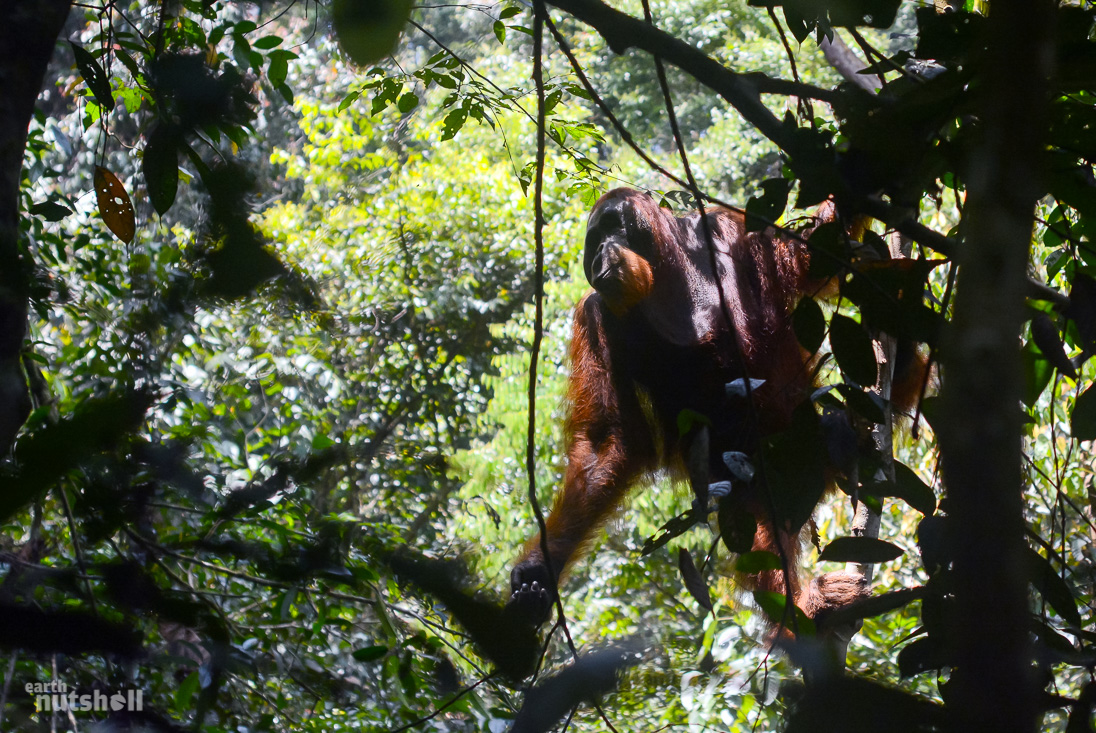
What to expect?
Orangutans. Seriously, this may sound stupid – but for every person to visit neighbouring Borneo with the specific intention of catching a glimpse of an Orangutan, there is one that leaves without a sighting. Time, energy and money spent on trekking can be quickly drained, as will your initial hopes when you consistently come up empty.
Most lodging in Bukit Lawang employs local educated guides to organise treks into Gunung Leuser National Park. They are passionate, knowledgeable and have usually grown ingrained to the law of the land. They will organise and front rainforest trips that are tailored to your requirements.
Only have one day to see Orangutans? Check.
Overnight, camping with monkeys and tubing the river? Check.
Want to spend seven days living off the grid in the jungle? Check.
One thing is certain, they want you to see Orangutan! This assurance helps to justify your travel here.
Other things to expect in Bukit Lawang are:
- Orangutan rehabilitation feeding platform – About 10 minutes stroll, you can make your way up to see semi-wild Orangutans descend twice daily for a feed.
- The bat cave – Dark, claustrophobic and bats…so many bats.
- Monkeys – Including beautiful Thomas Leaf Monkeys.
- Relaxation – The village has a laid back atmosphere, locals are lovely and the trickling sound of the river prefaced by the sounds of the jungle seem designed for afternoons spent reading.
- Swimming – Right outside your lodging, popular with the locals too.
- Tubing – The river has low grade rapids, and it’s heaps of fun.
- Waterfalls – They can be reached during hikes, perfect for a ‘traditional massage’ as the locals would say.
- Mosquitos – As certain as day goes into night. Bring repellant.

How do I get there?
- If you fly into Medan, you’ll now fly into the new Kuala Namu airport. It’s the same distance (30km) from Medan as it is from Bukit Lawang direct.
- There is no accommodation at Kuala Namu airport (2015), so either stay in Medan overnight or head straight to Bukit Lawang if you have time (private car takes 4 hours).
- Private, air conditioned vehicle from Medan or Kuala Namu to Bukit Lawang is about $40 USD one-way, split between a couple, or fellow tourist, it’s not bad.
- Tourist Buses (Mini-van) run from Medan, Berastagi or Lake Toba very regularly. From Medan they cost about $10 USD each but only run if filled.
- Local Bus is possible and very cheap ($1 USD) from Medan. It will be crowded, slow and questionably safe with no air conditioning.
- Booking online isn’t possible for most lodges. I recommend just turning up. The locals will pounce on the opportunity to lodge you, as you will likely jungle trek with them too. Don’t be afraid to say no initially and take a look around, Bukit Lawang is only a 20 minute stroll one side to the other and has a range of accommodation.
What time of year?
- You can expect to see Orangutans all year round, this is a huge advantage by visiting Bukit Lawang.
- The weather in Sumatra is tropical, so expect it to be hot with a possibility of rain all year round – even during ‘dry’ season.
- Orangutans can be seen closer to the ground between April and November, as the trees are fruiting.
- Torrential rains occur primarily in the ‘wet’ season between October and Febuary.
- The ‘dry’ season is accepted as being between March and September.
- Tourism peak is between June and August.
- I went in March. It was quiet and as you can see, there was no shortage of Orangutan!
- If possible, try to avoid Indonesian public holidays as it will be far busier. Weekends generally see higher occupancy too.
How much will it cost me?
- Cost varies, as you’d expect. However, I found that price was strongly correlated with quality. Remember this.
- Offered through my lodging, my trek cost $75 USD. This is on the high side.
- This was a two-day, overnight trek into Gunung Leuser including knowledgeable English speaking guides, meals and camping facilities. Tubing down the river back to Bukit Lawang is catered with appropriate water proofing – you’ll have your camera remember. It’s essential.
- For many lodges, price fluctuates with the time of year and you can usually haggle. June-August (high tourist season) is usually busiest and most expensive.
- You may be offered similar overnight treks on paper for less; through other lodging or guides that approach you in the village. This is fine, but ensure they are an official guide. Regardless, some shortcuts on quality may be taken, this could be as simple as gear, less catering or a less hospitable camping location. Just be aware.
- Bukit Lawang is small. Reputations are built in Bukit Lawang. The friendly and communal atmosphere allows you to get to know many guides prior to commitment, use this opportunity if you are unsure!
Before visiting; remember these:
- There will be mosquitoes, lots of them. Bring mosquito repellent.
- There are no ATMs. There is also no means of electronic payment. At all. Get as much money as you think you’ll need in Medan, then take some more just in case. You’ll need to pay for accommodation, guides, food and possibly a tip, maybe a souvenir.
- It’s illegal to trek alone, or without a guide. Not only that, it’s incredibly dangerous, stupid and irresponsible. Entering the rainforest without a guide or proper equipment will almost certainly result in disorientation, heatstroke or potential injury. Don’t come to Bukit Lawang with this in mind.
- On that note, ensure you have travel insurance.
- If you do hurt yourself, medical care is limited. Nurse, doctor and pharmacist will be the same person.
- Bring good walking shoes. Seriously. The trek is hilly, awkward and slippery – you’ll need grip, even on a single day trek.
- Bukit Lawang does have power. But it also has regular power outages. Bring a USB recharging block or a spare battery for your camera.
- Bring a torch.
- There’s a tiny internet cafe in Bukit Lawang and some of the lodges have Wifi. However, the 3G coverage is fantastic. Data is cheap in Indonesia, consider getting a local Simpati simcard in Medan. It served me well.
- Bring swimming gear, take it on your trek. You’ll have ample opportunity to swim – even right outside your lodging.
- Do not hike in cotton. Trust me.
- Keep you’re belongings safe. Not from humans, but from monkeys. Bukit Lawang is in the jungle – if you leave your lodging door open, you’ll have a monkey infestation and likely no underwear for tomorrow.
P.S – Have you visited wild Orangutan elsewhere? How does it compare? Let me know in comments below – I’d love to hear about your experience!
Interested in Indonesia? More coming soon! Follow me on Facebook!
The post Seeing Wild Orangutans In Indonesia appeared first on Earth Nutshell.

